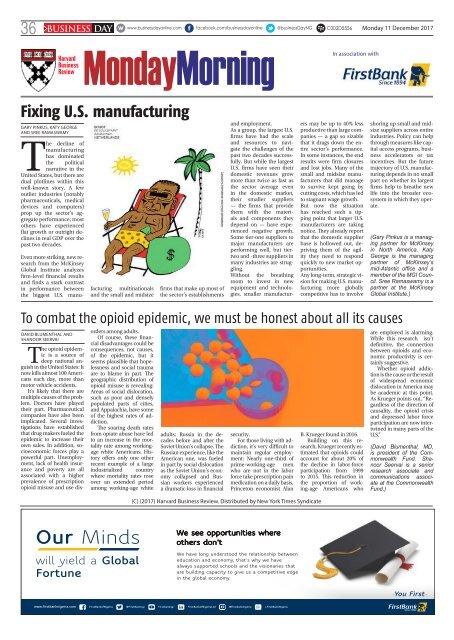BusinessDay 11 Dec 2017
Create successful ePaper yourself
Turn your PDF publications into a flip-book with our unique Google optimized e-Paper software.
Monday <strong>11</strong> <strong>Dec</strong>ember <strong>2017</strong><br />
36 BUSINESS DAY<br />
C002D5556<br />
Harvard<br />
Business<br />
Review<br />
MondayMorning<br />
In association with<br />
Fixing U.S. manufacturing<br />
Gary Pinkus, Katy George<br />
and Sree Ramaswamy<br />
The decline of<br />
manufacturing<br />
has dominated<br />
the political<br />
narrative in the<br />
United States, but there are<br />
dual plotlines within this<br />
well-known story. A few<br />
outlier industries (notably<br />
pharmaceuticals, medical<br />
devices and computers)<br />
prop up the sector’s aggregate<br />
performance; most<br />
others have experienced<br />
flat growth or outright declines<br />
in real GDP over the<br />
past two decades.<br />
Even more striking, new research<br />
from the McKinsey<br />
Global Institute analyzes<br />
firm-level financial results<br />
and finds a stark contrast<br />
in performance between<br />
the biggest U.S. manu-<br />
and employment.<br />
As a group, the largest U.S.<br />
firms have had the scale<br />
and resources to navigate<br />
the challenges of the<br />
past two decades successfully.<br />
But while the largest<br />
U.S. firms have seen their<br />
domestic revenues grow<br />
more than twice as fast as<br />
the sector average even<br />
in the domestic market,<br />
their smaller suppliers<br />
— the firms that provide<br />
them with the materials<br />
and components they<br />
depend on — have experienced<br />
negative growth.<br />
Some tier-one suppliers to<br />
major manufacturers are<br />
performing well, but tiertwo<br />
and -three suppliers in<br />
many industries are struggling.<br />
Without the breathing<br />
room to invest in new<br />
equipment and technologies,<br />
smaller manufacturfacturing<br />
multinationals<br />
and the small and midsize<br />
firms that make up most of<br />
the sector’s establishments<br />
ers may be up to 40% less<br />
productive than large companies<br />
— a gap so sizable<br />
that it drags down the entire<br />
sector’s performance.<br />
In some instances, the end<br />
results were firm closures<br />
and lost jobs. Many of the<br />
small and midsize manufacturers<br />
that did manage<br />
to survive kept going by<br />
cutting costs, which has led<br />
to stagnant wage growth.<br />
But now the situation<br />
has reached such a tipping<br />
point that larger U.S.<br />
manufacturers are taking<br />
notice. They already report<br />
that the domestic supplier<br />
base is hollowed out, depriving<br />
them of the agility<br />
they need to respond<br />
quickly to new market opportunities.<br />
Any long-term, strategic vision<br />
for making U.S. manufacturing<br />
more globally<br />
competitive has to involve<br />
shoring up small and midsize<br />
suppliers across entire<br />
industries. Policy can help<br />
through measures like capital<br />
access programs, business<br />
accelerators or tax<br />
incentives. But the future<br />
trajectory of U.S. manufacturing<br />
depends in no small<br />
part on whether its largest<br />
firms help to breathe new<br />
life into the broader ecosystem<br />
in which they operate.<br />
(Gary Pinkus is a managing<br />
partner for McKinsey<br />
in North America. Katy<br />
George is the managing<br />
partner of McKinsey’s<br />
mid-Atlantic office and a<br />
member of the MGI Council.<br />
Sree Ramaswamy is a<br />
partner at the McKinsey<br />
Global Institute.)<br />
To combat the opioid epidemic, we must be honest about all its causes<br />
David Blumenthal and<br />
Shanoor Seervai<br />
The opioid epidemic<br />
is a source of<br />
deep national anguish<br />
in the United States: It<br />
now kills almost 100 Americans<br />
each day, more than<br />
motor vehicle accidents.<br />
It’s likely that there are<br />
multiple causes of the problem.<br />
Doctors have played<br />
their part. Pharmaceutical<br />
companies have also been<br />
implicated. Several investigations<br />
have established<br />
that drug makers fueled the<br />
epidemic to increase their<br />
own sales. In addition, socioeconomic<br />
forces play a<br />
powerful part. Unemployment,<br />
lack of health insurance<br />
and poverty are all<br />
associated with a higher<br />
prevalence of prescription<br />
opioid misuse and use dis-<br />
orders among adults.<br />
Of course, these financial<br />
disadvantages could be<br />
consequences, not causes,<br />
of the epidemic, but it<br />
seems plausible that hopelessness<br />
and social trauma<br />
are to blame in part. The<br />
geographic distribution of<br />
opioid misuse is revealing:<br />
Areas of social dislocation,<br />
such as poor and densely<br />
populated parts of cities,<br />
and Appalachia, have some<br />
of the highest rates of addiction.<br />
The soaring death rates<br />
from opiate abuse have led<br />
to an increase in the mortality<br />
rate among workingage<br />
white Americans. History<br />
offers only one other<br />
recent example of a large<br />
industrialized country<br />
where mortality rates rose<br />
over an extended period<br />
among working-age white<br />
adults: Russia in the decades<br />
before and after the<br />
Soviet Union’s collapse. The<br />
Russian experience, like the<br />
American one, was fueled<br />
in part by social dislocation<br />
as the Soviet Union’s economy<br />
collapsed and Russian<br />
workers experienced<br />
a dramatic loss in financial<br />
security.<br />
For those living with addiction,<br />
it’s very difficult to<br />
maintain regular employment:<br />
Nearly one-third of<br />
prime-working-age men<br />
who are not in the labor<br />
force take prescription pain<br />
medication on a daily basis,<br />
Princeton economist Alan<br />
(C) (<strong>2017</strong>) Harvard Business Review. Distributed by New York Times Syndicate<br />
B. Krueger found in 2016.<br />
Building on this research,<br />
Krueger recently estimated<br />
that opioids could<br />
account for about 20% of<br />
the decline in labor-force<br />
participation from 1999<br />
to 2015. This reduction in<br />
the proportion of working-age<br />
Americans who<br />
are employed is alarming.<br />
While this research isn’t<br />
definitive, the connection<br />
between opioids and economic<br />
productivity is certainly<br />
suggestive.<br />
Whether opioid addiction<br />
is the cause or the result<br />
of widespread economic<br />
dislocation in America may<br />
be academic at this point.<br />
As Krueger points out, “Regardless<br />
of the direction of<br />
causality, the opioid crisis<br />
and depressed labor force<br />
participation are now intertwined<br />
in many parts of the<br />
U.S.”<br />
(David Blumenthal, MD,<br />
is president of the Commonwealth<br />
Fund. Shanoor<br />
Seervai is a senior<br />
research associate and<br />
communications associate<br />
at the Commonwealth<br />
Fund.)


















